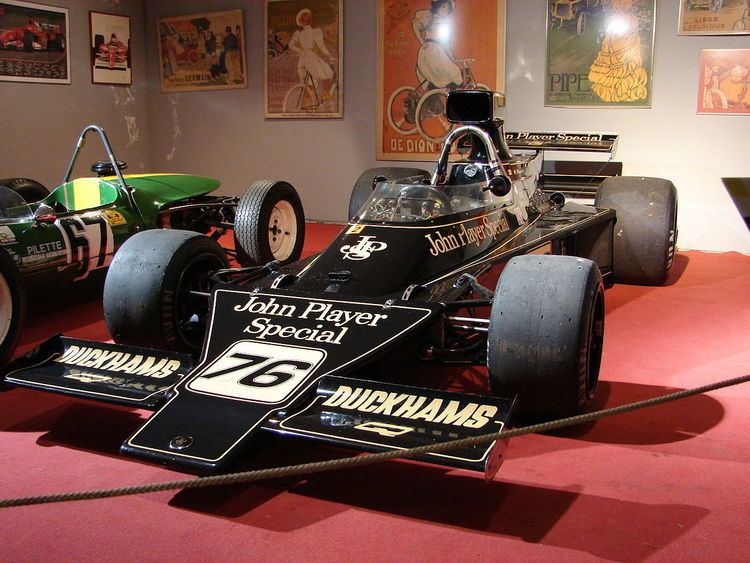Wheelbase 2,565 mm (101.0 in) | ||
 | ||
Axle track 1,473 mm (58.0 in) front, 1,575 mm (62.0 in) rear | ||
The Lotus 76 was a Formula One car designed by Colin Chapman, Tony Rudd and Ralph Bellamy for the 1974 Formula One season. The car was intended to be a more advanced version of the Lotus 72, powered by the Ford Cosworth DFV and featuring modified aerodynamics, a lighter chassis, longer wheelbase and a narrower, lower monocoque. The car also featured a bi-plane rear wing, designed to increase rear downforce and stability. In addition to an electronically operated clutch, which was the precursor to the modern semi automatic gearboxes seen on today's F1 cars, with the control mounted into the gearstick which theoretically speeded up gearchanges. The Lotus 76 was seen as a major technological breakthrough by Team Lotus. Outwardly, the car looked sleek and impressive. Internally, the suspension set up and inboard brake positioning were carried over from the Lotus 72. The car's development had been paid for by title sponsor John Player Special, so the 76 was given the chassis number 'John Player Special Mk I.'
After initial tests by Ronnie Peterson and Jacky Ickx, both drivers complained that the car lacked 'feel' and that the electronic clutch was giving problems. The gearchange was modified, but both drivers persisted in claiming it was no better than the conventional clutch setup. Other problems with the engine installation were encountered, which led to mechanical failures and the car's weight bias being out of sync. The car made its debut at the 1974 South African Grand Prix, Ickx qualified 10th and Peterson qualified 16th, During the race the Swede retired after a collision with the Belgian who also retired when his brakes failed. At Spain, Peterson qualified 2nd and Ickx qualified 5th, but both retired when their brakes failed. The Belgian Grand Prix saw the Swede qualify 5th and the Belgian 16th. During the race Peterson retired with a fuel leak and Ickx disappointed his home crowd with overheating problems. Afterwards, both drivers insisted on going back to the Lotus 72, which Peterson promptly used to challenge for the world championship. Chapman responded by upgrading the 76 to 'B' spec, with enlarged sidepods and better cooling. It was not seen until the German Grand Prix with Peterson. He qualified 8th and finished 4th. At Austria, Ickx qualified 22nd and retired after a collision. At the Italian Grand Prix, Ickx qualified 16th and retired with a throttle problem. Lotus entered Tim Schenken for the United States Grand Prix. He failed to qualify but started illegally from 27th place on the grid and completed six laps before he was disqualified. The team eventually had to accept that the 76 was a step in the wrong direction, and the whole project was scrapped in favour of keeping the 72s competitive.
Complete Formula One World Championship results
(key)
* 39 points scored using the Lotus 72
